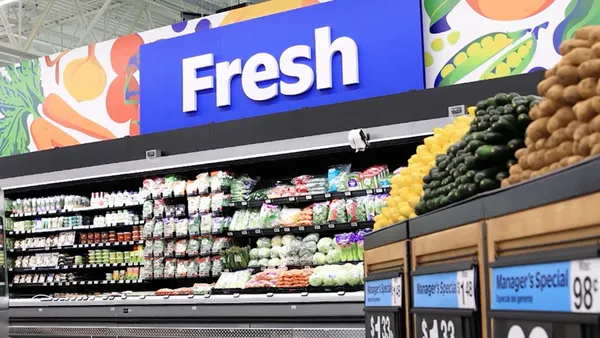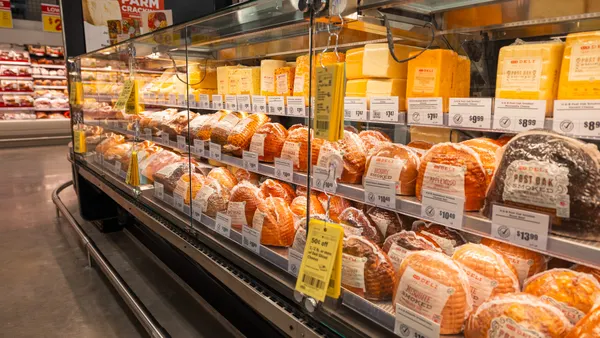Dive Brief:
- Food-at-home prices increased 10.8% over the past year — the largest 12-month increase since November 1980 — according to Consumer Price Index (CPI) data for April released by the U.S. Bureau of Labor Statistics (BLS) on Wednesday.
- The monthly food-at-home index rose 1% in April from the 1.5% increase recorded in March.
- Increases in the costs of food, shelter, airline fares and new vehicles were the biggest factors behind the annual CPI increase for all items of 8.3% in April, which is slightly down from the record-breaking inflation rate of 8.5% recorded in March.
Dive Insight:
Grocery prices in April rose for five of the six major food categories. Dairy and related products rose 2.5%, marking its largest monthly increase since July 2007. Nonalcoholic beverages followed as the second-highest index with a 2% increase. The 1.4% price increase in April for meats, poultry, fish, and eggs was driven by eggs skyrocketing 10.3%.
Fruits and vegetables, meanwhile, was the only index that dropped for the month, declining 0.3%, down from the 1.5% jump recorded in March.
On a year-over-year basis, prices for all of the food-at-home categories increased. Meats, poultry, fish and eggs jumped up 14.3%, marking the largest 12-month increase since May 1979. Other categories logging steep annual increases included fruits and vegetables (7.8%), cereals and bakery products (10.3%), and eggs (22.6%).
Food-away-from home sales, by comparison, rose 7.2% over the past 12 months and 0.6% over March, according to the latest BLS figures.
As food prices have increased, the continued pressure on shoppers' wallets is starting to impact their buying habits. In their e-commerce sales report for April, which showed a 4% sales decline over the same month last year, Brick Meets Click and Mercatus noted that inflation is impacting how consumers are buying groceries online.
During Grocery Outlet's first quarter earnings call on Tuesday afternoon, company executives said suppliers continue to incur higher costs due to inflation affecting the cost of ingredients, packaging, freight and labor, and noted that inflation impacted the discounter's gross margins for the quarter slightly more than expected.
"We don't profess to have a clearer crystal ball than anyone else out there, but suffice to say we expect [inflation] will remain elevated through the year. We'd expect to see larger year-over-year impact in the first half and as we start to lap some of those higher numbers in the back half of last year, that'll impact some of the growth rates," Charles Bracher, chief financial officer for Grocery Outlet, said on the call.
During Ahold Delhaize's first quarter earnings call on Wednesday, CEO Frans Muller said U.S. consumers remain "very strong" and that the company has been passing along higher prices in stores. He said its U.S. banners are offering more price promotions and plan to further emphasize its private label selection.
These chains, like other grocers, are trying to balance how to offer deals and low prices to price-sensitive customers while at the same time passing along some of the higher costs to them.
President Joe Biden is expected to unveil steps to tackle food inflation on Wednesday after releasing a statement calling inflation “unacceptably high," Bloomberg reported.














